I often encounter students who position their hand high like this, and it is something I discuss with them due to the fact that it slows their draw down because they have to bring the hand down and under the handgun to get it on the grip when forming their grip. This also affects how well they build their final firing grip and ultimately how well they shoot. Their argument is always that the high (often up near the face) hand allows them to defend their head or throw a strike. While I consider this a valid argument, I ask if they are close enough to strike the opponent, is drawing at that time (and distance) the best option? This makes them think and most of the time their answer is no.
Quick Draw Handgun Techniques and Types
This discussion led me to write this article, because I think there is a huge gap between what a purist may call a combative-type draw process, and a speed draw that a competitive shooter or someone training to improve their draw on a flat range might use. A huge amount of data exists, including video of real-time attacks and full-contact training scenarios, and the experiences of instructors such as USSA Adjunct Staff, Craig Douglas (SouthNarc), and Michael Janich, who have tested the concepts of accessing the firearm at close range. All the data points to empty-hand skills being one of the most under-trained and important skills a defender must have.
Let me make one point clear in terms of selecting an appropriate response: There is rarely such a thing as right or wrong. But there is such a thing as better or worse. This article is intended to stimulate thought, not to label any one type of technique definitively right or wrong.
I will present some options to improve your ability to get the gun into the fight if necessary, as well as show that there is no one “right answer” when it comes to getting the gun into the fight. Let’s assume two things: you are involved in a fight, and lethal force is warranted (or will be at some point during the fight).
First, let me define the draw process terms I will use (there are other terms, but these will help you understand what I am referring to):
Speed Draw
Accessing the firearm from a holster with the simple intent of hitting a target as fast as possible (in whatever target area the user deems to be an acceptable hit).
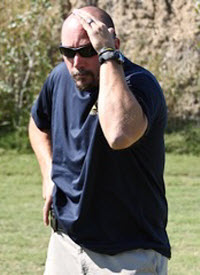
Theoretical goal for this draw is to have the ability to use the off hand to defend the head or strike. Here, off hand is in defensive position around the head.
Combative Draw
Used and taught in defensive and tactical circles, this process emphasizes accessing the firearm from a holster with the intent of being able to use the off hand to strike or defend. This draw differs from a speed draw in that the end user is less concerned with speed to the first shot. More emphasis is placed on technique that will allow the user to flow to a close-quarters position, shoot to extension (in some cases), etc.
Each process has a different emphasis (speed versus combative use of the off hand), and this is often where the line is drawn between competitive and tactical (defensive) shooters. I will attempt to erase that line by getting you to think about the end goal in the fight at different distances.
You might be wondering which draw process I embrace. The answer is neither! I don’t think of fighting from a “one answer” angle. I approach the fight from a principle-based angle and believe that if the end user trains for and follows the basic principles that are dictated by distance, he will increase his chances of success. The following will help you better understand the different distances in the potential fight, and what I believe to be the best actions (and goal) at each distance.
To introduce certain principles and get you to think logically about what techniques might make more sense than others, let’s look at the fight in terms of distance, since it is the determining factor that dictates your best options to access the gun.
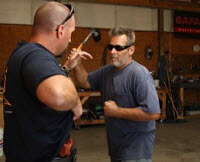
This is contact range, literally kissing distance. It is much too close to think about drawing without having an empty-hand response.
Extreme Close Range
Distance: One yard or less.
Attributes: Very close, most likely contact distance where the individuals are striking or grabbing each other. Body motion will be wild and aggressive. Maintaining a stationary position will be nearly impossible.
Correct Actions
While I defined the fight above as one where lethal force is warranted and the gun is a possible solution, it must be accessed at the right time. The most correct action at this distance is to use empty-hand techniques or movement to get same-side access control, disrupt the attacker’s attack, or create distance. The default answer in most defensive plans is to draw the gun as quickly as possible, and I strongly urge you to test this process in full-contact testing. You will quickly find that drawing the gun at the wrong time is the wrong solution in most cases.
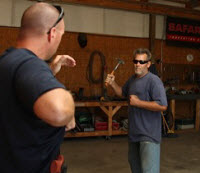
A common mistake at this range is choosing to draw the gun instead of reverting to another solution. It’s still too close in most cases, and the “gun” solution may not be the best option.
Close Range
Distance: Two to five yards.
Attributes: Close, within one or several steps to contact. Too close for most to effectively draw their gun and get shots on target unless a close-quarters technique is used.
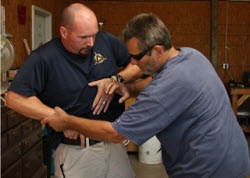
This is a perfect example of why just drawing the gun at close range is not an effective solution. Even striking first or stepping back are not effective methods of getting the gun out, and often the draw will become fouled by the threat.
The goals at this distance are very similar to the extreme close-range goals. This is because the distance can be closed so fast that you can find yourself in a close-range attack that turns into a contact-distance attack in about one second. I recommend creating distance in this case, but to be honest, getting distance against someone motivated to close that distance is nearly impossible. In cases where distance cannot be gained, you must simply default to empty-hand techniques to disrupt the attacker or gain same-side access and control.
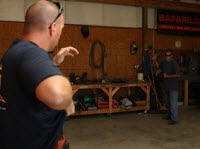
This distance allows enough time to actually perform a true speed draw. Remember that stepping offline to cover or just moving offline of the attack are great skills to utilize during the draw process.
Medium to Long Range
Distance: Seven or more yards.
Attributes: Long-distance attack, rarely found in civilian self-defense situations. Far enough for skilled end users to effectively draw their gun and get shots on target.
Goals: Keep distance with lateral or angular offline movement. Place obstacles between the aggressor and yourself. Access the firearm after or during movement offline. Maintaining a stationary position is the worst thing to do unless the situation requires it (e.g., family members to protect, no space to move), because even though the distance allows a speed draw, the shots on target may not effectively stop the threat if he is closing distance quickly. Using movement to extend the distance or placing obstacles between you are often the best choices, and doing this while drawing might compromise the movement. If cover or an obstacle are not options, utilize the fastest draw possible to get shots on target to neutralize your attacker.
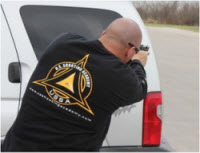
If distance allows a standard speed draw, getting the gun out quickly and stepping offline to any available cover are the keys.
Correct Actions
Accessing the firearm is important, but when you break down the process, the most important action is often to move as opposed to draw. As with the close-quarters default response of drawing, I have often found that the default at longer ranges is to draw the gun while standing still, even against an aggressor who has already established a grip on his own weapon (gun or knife). In this case, drawing while standing still almost always results in getting shot or cut.
You cannot outdraw someone who has already accessed a gun, and even if you use the fastest speed draw in the world, you will likely not effectively stop the threat fast enough to keep from getting shot. A knife or contact weapon armed opponent will close the distance very quickly and, unless movement is used to keep the space or an obstacle is placed between you and the aggressor, the fight will turn into a close-quarters battle once again. Movement offline (left, right, or at slight angles in these directions toward obstacles or cover) is the key. Sprint movement is often best, but several aggressive steps in either direction if there is a close obstacle are also effective.
Drawing will often slow the movement down, so unless you can effectively draw from standing still to a dead sprint, I recommend moving first and then drawing when you get to where you are going. A caveat: some of you may not have the physical ability to move like this. Your options are limited but simple enough. Use an effective speed draw to get shots on target and hopefully neutralize the threat before he can harm you or others.
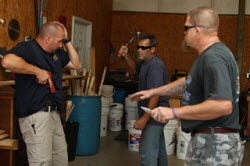
This is one of the few times I would draw the gun using the off hand in a combative position. I cannot move, am confronted with two armed attackers, and have decided that the only chance I have is to get the gun into play while trying to use the off hand to defend or strike.
Exigent Circumstances (Range is obsolete and variable)
I am not breaking this down the same way as the various distance encounters, because there are circumstances when the most logical and potentially effective responses are not possible. An example might be a close- to medium-range assault by multiple adversaries while your family members are with you. Sprinting offline to a position of cover or placing an obstacle between you might not be possible because you would be leaving your family.
There is no best choice in these exigent circumstances, but the general principles should be adhered to if possible. Use empty-hand techniques to get to the gun, and don’t forget that distance is your friend. In extreme cases, consider bringing the fight to the adversary (akin to assaulting the ambush). Make sure you have discussed your plan with your team/family so they know what will happen and have their own action plan (hopefully they can move offline).
In this particular case, I feel the combative draw process might be a good technique to use, but only for the key reasons stated above. Another situation where I might recommend the combative draw process to certain students is in cases where movement is restricted due to physical limitations. A person who has no chance to move offline quickly may be forced to draw the gun when closer than desired, but I caution: This move needs to be refined and practiced before it has any chance of success!
Complex Questions
Having discussed the distances and possible solutions at each, I hope you can see that there is much more to effective self defense than practicing a speed draw or combative draw on the range and automatically defaulting to drawing a gun during any given fight. Getting the gun into the fight is more complex than just using a particular draw type you practiced at the range.
I teach and believe that there might be a use for each of the draw types that I defined above, but here is what I try to get students to think about in relation to each:
Combative Draw
The idea that you should place the off hand in a defensive position while drawing is a valid concept in some situations, but generally counterproductive to the goal, which is getting the gun out quickly (at that distance). Once again, this is because if you are at a distance that allows use of the off hand to strike or defend, you are probably too close to be reaching for the gun unless you are indeed in an exigent type circumstance as described above. A situation where I might agree with this type of draw process would be one during which the user had no choice but to try to get a gun into the fight, while in close range of multiple attackers.
Speed Draw
Although I do believe in the value of a fast draw process, what I want to point out is that in most cases, simply trying to use a speed draw to win the fight might be a poor choice. I have observed this during the dozens of training scenarios I have placed students armed with NLTA ammunition in. I place them in a simulated robbery (at medium to long range), and time after time they automatically default to trying to draw their gun and shoot it out. They often get hits on the bad guy, but always get hit multiple times themselves, which is a losing option if it can be avoided. Simply using movement before accessing their weapon increases their survivability by decreasing (often greatly) the amount they get hit.
Practice Sessions
So what draw do I train and believe in? I practice the skills I believe I will need at the appropriate distances. Here are the skills sets I train regularly and test with armed role-players utilizing NLTA:
Defending my head, throwing effective counterstrikes (Extreme and Close Ranges), and getting into a position with an aggressor where I have same-side access control.
Using a one-handed shooting position from contact distance (Extreme and Close Ranges).
Using a speed draw (from concealment and my carry holster) after moving aggressively and while moving at various angles (Medium Ranges) offline.
Using the speed draw (again from concealment) with a timer to measure my speed to get effective hits on target from a static position, sometimes around a piece of simulated cover (Long Range and Exigent Circumstances).
Summary
I hope to have opened your mind about how you might access your firearm to get it into the fight. I am not saying there is a particular “right or wrong” way to draw. I simply want you to understand that there are many other relevant considerations when attempting to get the gun into the fight. I encourage you to base your future training on principle-based solutions depending on the situation you are in!
Share tips, start a discussion or ask one of our experts or other students a question.
Already a member? Sign in
13 Responses to “Getting the Gun Into the Fight: Quick Draw Handgun Techniques”
Premium Membership
Unlock exclusive member content from our industry experts.
- 24/7 Access to Premium Personal Defense and Firearm Training Videos and Drills
- Step-by-Step Instructional Demos and Guides
- 50% Off Video Downloads Purchased in the Personal Defense Network Shop
- Access to Ask the Expert Program
Unlock exclusive member content from our industry experts.
- 24/7 Access to Premium Personal Defense and Firearm Training Videos and Drills
- Step-by-Step Instructional Demos and Guides
- 2 Full-Length Video Downloads to Watch Offline
- 50% Off Video Downloads Purchased in the Personal Defense Network Shop
- Access to Ask the Expert Program
Gold Membership
$340 Value
Get everything included in Premium plus exclusive Gold Membership benefits.
- 24/7 Access to Premium Personal Defense and Firearm Training Videos and Drills
- Step-by-Step Instructional Demos and Guides
- 9 Full-Length Video Downloads to Watch Offline
- 2 Full-Length Personal Defense Classes to Keep for Life
- 2 In-Depth Skill Development Presentations
- Discounts on Purchase-to-Own Content in the Personal Defense Network Shop
- Access to Ask the Expert Program
- Exclusive GOLD LIVE Streaming Events
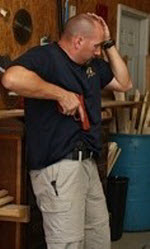

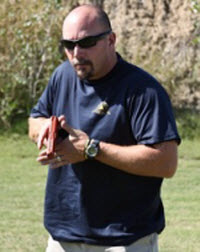
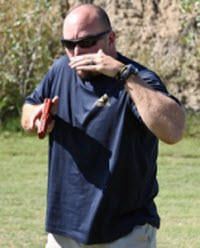
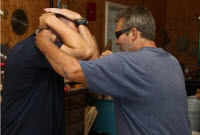
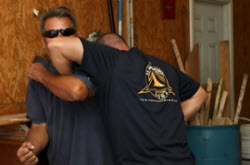

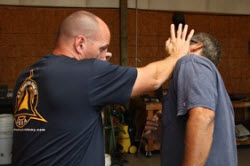
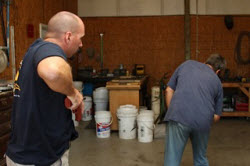
Enjoy reading your work, Thank you.
What are the names of some of the appendix carry style holsters?
I look forward to receiving your insights.
buy karen millen outlet to take huge discount FjtWNTqA
Not sure if you emphasized it enough. I believe in close range combat and self defense, it is important to utilize the side step (as is taught in almost all hand to hand combatives). While side stepping, you move out of the way of your opponent's direct attack, you give yourself a few extra seconds to defend or grab your firearm/weapon, and it gives you a good angle to counter-attack from a blind side. Just something to think about and add to your next article.
very well presented
Nice Articles Mike, I will be sending these to my instructors. Thanks,
Yes! After many years in martial arts and with several in JKD Kali where we constantly talk about range, forward pressure and test options in live drills with spontaneous attacks I can say I love what PDN is saying. Read and then practice what you find on this website! Its not the techniques its the training methoeds, its not about hardawre (gun) as it is software (mental).
What about WE Fairbairns cross draw carry - lass and more natural movement leaving the left hand free to fend off?
David- I think you understand the article now, but if not please feel free to email me at mikeseeklander@shooting-performance.com anytime! Thanks for reading.